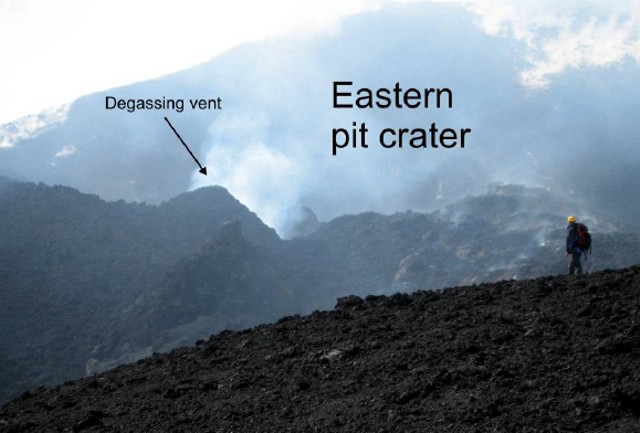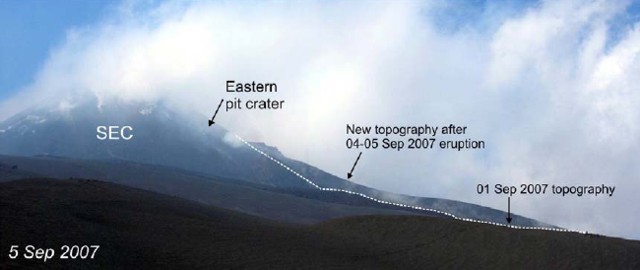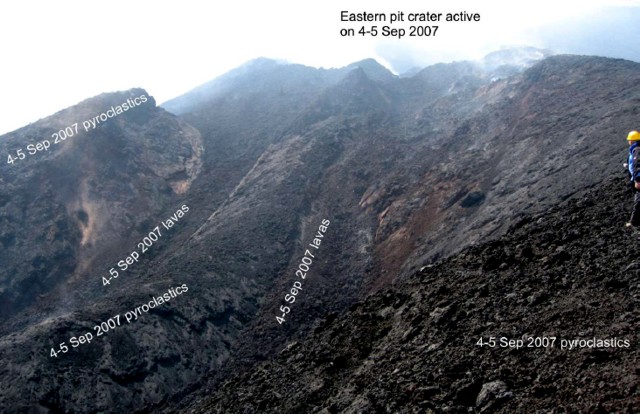Report on Etna (Italy) — August 2007
Bulletin of the Global Volcanism Network, vol. 32, no. 8 (August 2007)
Managing Editor: Richard Wunderman.
Etna (Italy) Explosive activity and lava fountains during 4-5 September 2007
Please cite this report as:
Global Volcanism Program, 2007. Report on Etna (Italy) (Wunderman, R., ed.). Bulletin of the Global Volcanism Network, 32:8. Smithsonian Institution. https://doi.org/10.5479/si.GVP.BGVN200708-211060
Etna
Italy
37.748°N, 14.999°E; summit elev. 3357 m
All times are local (unless otherwise noted)
A report by members of the Istituto Nazionale di Geofisica e Volcanologia di Sezione Catania (INGV-CT), Behncke and Neri (2007), discussed Etna's 4-5 September eruption. On 6 September field work on the eastern zone of the Southeast Crater (SEC) revealed profound morphologic changes. The SEC's eastern pit crater was the source of lava flows.
The erupted material was distributed mostly to the E, covering the plateau between the base of the SEC and the western rim of the Valle del Bove with a thickness ranging from a few meters to more than 25 m (figure 124). The accumulation of welded scoria formed a mound more than 700 m long.
The scoria mound, which formed by falling material, was composed primarily of extremely light and vesicular scoria, of varying size, from less than a centimeter to meters, oxidized and reddish in color. The thickness of the scoria deposits varied from over 25 m at the base of the SEC to about 8 m in the area around the western rim of the Valle del Bove, behind hornitos at ~ 2,800 m elevation, which formed during the 2006 eruption.
The scoria appeared to have moved after landing. In addition, localized movement also occurred along some wide-opening fracturing.
During the formation of the scoria mound, lava descended as three principal streams. The streams emerged from the SE sector of the eruptive crater (venting at the Eastern pit crater) (figure 125).
The field observers saw the southern rim of the eruptive crater and the zone beneath it. To an elevation of about 2,800 m, these rocks emitted fumarolic vapors and contained hot fractures. The position of this fissure field appeared to coincide, at least in part, with what had already been identified by thermal telecamera during the helicopter survey carried out by the governmental Regional Civil Protection. Inside the 4-5 September eruptive vent (Eastern pit crater seen in figures 125 and 126), the team also saw a point of continuous and pulsating gas emissions.
 |
Figure 126. At Etna's SEC, this photo shows the degassing vent inside the active crater. Courtesy of INGV. |
Reference. Behncke, B. and Neri, M., 2007, L'eruzione del 4-5 settembre 2007 al Cratere di Sud-Est (Etna): osservazioni di terreno in prossimit? della bocca eruttiva; copyrighted report of the INGV-CT (posted on their website and accessed October 2007).
Geological Summary. Mount Etna, towering above Catania on the island of Sicily, has one of the world's longest documented records of volcanism, dating back to 1500 BCE. Historical lava flows of basaltic composition cover much of the surface of this massive volcano, whose edifice is the highest and most voluminous in Italy. The Mongibello stratovolcano, truncated by several small calderas, was constructed during the late Pleistocene and Holocene over an older shield volcano. The most prominent morphological feature of Etna is the Valle del Bove, a 5 x 10 km caldera open to the east. Two styles of eruptive activity typically occur, sometimes simultaneously. Persistent explosive eruptions, sometimes with minor lava emissions, take place from one or more summit craters. Flank vents, typically with higher effusion rates, are less frequently active and originate from fissures that open progressively downward from near the summit (usually accompanied by Strombolian eruptions at the upper end). Cinder cones are commonly constructed over the vents of lower-flank lava flows. Lava flows extend to the foot of the volcano on all sides and have reached the sea over a broad area on the SE flank.
Information Contacts: Sonia Calvari, Boris Behncke, and Marco Neri, Istituto Nazionale di Geofisica e Vulcanologia (INGV), Sezione di Catania, Piazza Roma 2, 95123 Catania, Italy.



